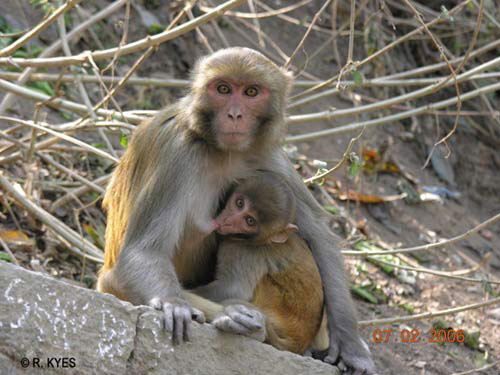Odd Form of 'Love' Hormone Found in Some Monkeys

The so-called "love and trust" hormone called oxytocin, originally discovered in the monogamous prairie vole, has been found in an odd form in a monkey species.
"This is the first time oxytocin has been reported to be different in any mammal ever studied," said researcher Karen Parker at Stanford University."The orthodoxy in the field was that all mammals have one form of oxytocin."
Oxytocin is a brain hormone that regulates parts of mammalian reproduction, including lactation and labor, but also is involved in social behaviors such as bonding between partners and mother-and-child, hence its unofficial "love” hormone moniker.
It is released by a part of the brain called the pituitary gland and travels throughout your system. It was widely thought to be exactly the same in all mammals, since it plays such an important part in reproduction and social bonding.
Social species
When studying her lab monkeys, Parker was having trouble measuring their oxytocin levels. "We had been trying for years to measure oxytocin levels in our monkeys," she told LiveScience. "On a lark, we sequenced the gene."
Surprisingly, the gene for oxytocin was different than any other mammal. They compared this new sequence with several other related species of New World monkey, including lab models like rhesus and capuchins. Many of these New World monkeys have this slightly different copy of the gene, which results in the gene producing a slightly different active protein.
Sign up for the Live Science daily newsletter now
Get the world’s most fascinating discoveries delivered straight to your inbox.
One of the amino acids, the molecules that make up proteins, is different. This amino acid is bigger, which might change the protein's structure or action, though the monkeys display normal social behaviors and have similar reactions to the traditional type of oxytocin as other mammals.
Experimental expectations
Researchers know that the monkeys react to the traditional form of oxytocin because they've studied its effects on these monkeys in the lab. It's possible that both the novel form and the traditional form act the same way in the monkeys, but researchers aren't sure.
"It plays such a critical role in social functioning," Parker said. "It's such a small peptide; any sort of mutation might undermine those critical functions. There is a strongly selected pressure to keep this molecule."
Parker and her team will continue investigating the activity of this new form of oxytocin to determine what kinds of effects it has compared with the original form.
It's important to elucidate these differences in these animals, especially since they include common laboratory species, said Karen Bales, a researcher at UC Davis who wasn't involved in the study. "Dr. Parker's findings are very exciting," she told LiveScience in an e-mail. "They should provide the impetus for future research, including the biological and chemical properties of the structurally different oxytocin."
The study was published today (March 15) in the journal Biology Letters.
You can follow LiveScience staff writer Jennifer Welsh on Twitter @microbelover.
Jennifer Welsh is a Connecticut-based science writer and editor and a regular contributor to Live Science. She also has several years of bench work in cancer research and anti-viral drug discovery under her belt. She has previously written for Science News, VerywellHealth, The Scientist, Discover Magazine, WIRED Science, and Business Insider.










